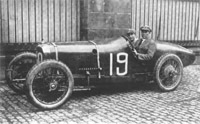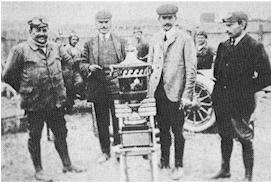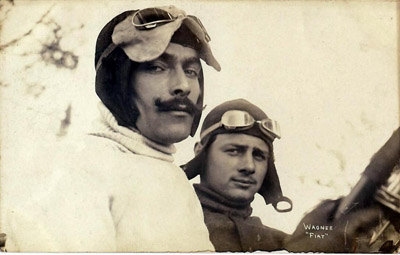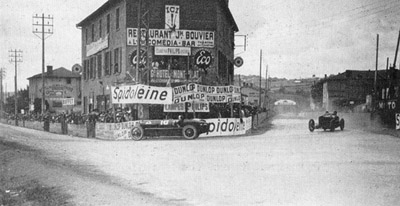The long reign of Louis Wagner
Author
- Rémi Paolozzi
Date
- October 28, 2008
Related articles
- The Gordon Bennett races - The birth of international competition, by Leif Snellman
- 1903 Gordon Bennett Trophy - Britain's first international motor race, by Brendan Lynch
- 1906 French Grand Prix - The first Grand Prix, by Leif Snellman
- 1914 French Grand Prix - Remember it for the one who lost, by Leif Snellman
- La Baule - Sandstorm, by Rémi Paolozzi
- Robert Benoist, 'Williams' & Jean-Pierre Wimille - A different danger, three champions at war, by Richard Armstrong
- Brooklands - World Record track, by Leif Snellman/Josh Lintz
- Christian Lautenschlager & Georges Boillot - Made the Greatest Grand Prix Ever, by Hans Etzrodt
- Dario Resta - The first king of America, by Rémi Paolozzi
- Ferenc Szisz - The first Grand Prix winner, by Geza Sury/Hans Etzrodt/Jimmy Piget
Who?Louis Wagner What?Rolland-Pilain A22 Where?Strasbourg When?A.C.F. Grand Prix (July 15, 1922) |
 |
Why?
1903 was the year of his first victory. His last one came in 1926. Between those two dates, Louis Wagner was among the most appreciated and talented drivers who through his experience was able to help a team forward during a period of extremely fast technical evolution. Today, Louis Wagner is one of the lesser known great drivers of his era, despite a handful of beautiful victories in Europe and in America as well.
Louis Wagner is born in Le-Pré-Saint-Gervais, near Paris, on February 5th, 1882. He is still a teenager when he starts working for Léon Bollée in Le Mans. Léon is the son of Amédée Bollée, who built his first car in Le Mans in 1873. In 1896 Amédée’s son builds a three-wheeled car, calling it Voiturette. It was the first time this word was used before it became very popular in the world of motor racing.
Wagner leaves Léon Bollée for Darracq in 1899. This car manufacturer, based in Suresnes near Paris, had been created in 1897 by Alexandre Darracq. It was about to become the third French manufacturer after Renault and Peugeot.
In 1903, Louis Wagner is only 21 when he takes part in a sadly famous race: Paris-Madrid. The race is stopped in Bordeaux because of a decision by the French government following the death of ten people, among them Marcel Renault, car manufacturer and brother of Louis Renault. Wagner is 30th when the race is definitely over. This is Wagner's first real race participation and immediately he has to face the cruel reality and dangers of the sport.
One month after this disaster, Wagner takes part with his Darracq in the Voiturettes Circuit des Ardennes in Arlon, Belgium. It is a two-lap race, the total distance being 272 km. This time it is a real success for the young driver. He wins and sets the fastest lap of the race! Wagner is the only driver covering the total distance in less than four hours. The second is Villemain, at the wheel of a second Darracq, who finishes over thirty minutes behind the winner.
In 1904 Wagner takes part in the French Elimination race of the Gordon Bennett Cup, the most important race at the beginning of the twentieth century. The race takes place in Argonne, a region between Reims and Verdun. It is a disappointment for the young French driver as he has to retire because of engine trouble.
The results in 1905 are better. He continues to work with Darracq, winning some hill climbs in Doullens and Liège. He cannot take part in the Gordon Bennett Cup because of a 4th position in the French Elimination race: only the first three cars are qualified and he and his mechanic Guillot miss the podium by 2’23’’6 after a race lasting nearly eight hours... Fortunately, on August 6th he wins the Voiturettes Circuit des Ardennes in Bastogne (Belgium). The day after he is 4th in the “true” Circuit des Ardennes. After a 6h30 race he finishes just ten seconds ahead of Heath’s Panhard. A good weekend. He also takes part in the Coppa Florio in Brescia - he is 8th - and, in October, he goes to the United States to enter the Vanderbilt Cup on Long Island. This race is like an “American Gordon Bennett Cup”. It is his very first American experience but he has to retire as early as the third lap.
The 1906 A.C.F. Grand Prix is considered by historians as the first GP ever. Wagner is among the glorious entrants who are the first Grand Prix drivers in history, but in fact the race remains a very short one for the 24-year-old, as he retires because of engine trouble during the second lap while laying 9th. His team mates Hémery and Hanriot also retire.
In August he is only 8th in the Circuit des Ardennes but sets fastest lap all the same. In October he is back to the States to take part in the Vanderbilt Cup, one of the most important races of the season. He is the sole Darracq driver. Fiat is there with Lancia, Nazzaro and Weillschott; Mercedes has come with Jenatzy and Luttgen, Itala with Cagno and Fabry, and there are of course American cars: a Locomobile driven by Tracy, a Frayer-Miller driven by Lawwell, a Haynes driven by Haynes….
The track is 20.7 miles long and situated in Long Island, New York. There are ten laps. In fact, the race is totally dominated by Wagner who leads from start to finish in really bad and wet weather. After six laps he is over seven minutes ahead of Lancia’s Fiat. After ten laps he wins in 4h50’, with Lancia over three minutes adrift.
To celebrate his victory, the young Wagner spends 48 hours in jail… because US policemen did not appreciate his way of driving on Broadway Avenue!
Unfortunately the race is not just remembered because of Wagner’s victory but also because of several accidents: Sheppard (Hotchkiss) and Weillschott (Fiat) went into the crowd with their racing cars. One spectator was killed and two boys were injured. The cruel reality of this sport at the beginning of the twentieth century…
The race also causes the death of two other American citizens: Mr Shirk and Mr Hesse. These two men could not stand an American defeat in the Vanderbilt Cup and decided to put an end to their own lives…
1907 begins with the Targa Florio where Wagner retires at the wheel of his Darracq. Nevertheless, his talent and his great victory on Long Island persuaded the Fiat managers to hire him into their racing team, one of the most prestigious of this era. Thus he is at the wheel of the Italian car in the Kaiserpreis in Germany where he is 5th while he has to retire during the A.C.F. Grand Prix in Dieppe after only three laps. The winner is his team mate, Felice Nazzaro.

Lancia, Agnelli, Nazzaro and Wagner
1908 is better. This new season, again with Fiat, begins with a third place in the Russian race between Saint-Petersburg and Moscow. He completes the 700km in about ten hours and wins the class 2 category. Then, Wagner and Ferro, his mechanic, retire both in the A.C.F. Grand Prix in Dieppe, after three laps, and in the Coppa Florio in Bologna, after four laps. At the end of the season he goes to the States one more time to take part in a big US race: the first American Grand Prize taking place in Savannah, Georgia, on Thanksgiving Day.
Wagner drives a 12 cylinder-Fiat 100HP. His riding mechanic is once again Antonio Ferro, his team mates are Ralph De Palma, one of the greatest American drivers and Felice Nazzaro, one of the best drivers of his time. The American Grand Prize is a 16-lap race. De Palma is the first leader, followed by Wagner. The Italian-American driver is the fastest but his tyres cannot stand the effort and De Palma is delayed. Wagner has the same problem and is sixth after three laps. Then Wagner succeeds in recovering ground, climbing into the top-four at mid-race. Then he takes the lead on lap 8, followed by Hémery (Benz), Nazzaro (Fiat) and Erle (Benz).
There is a big fight between the four drivers. Wagner loses the lead on lap 9 and takes it back on lap 11. Then, at the beginning of the last lap Nazzaro is leading, 1’54’’ ahead of Hémery and 1’56’’ ahead of Wagner… Given the fact that the best lap has been set by De Palma in 21’36”0 everything is possible. And Wagner makes it possible by winning the race 56” ahead of Hémery. Nazzaro is third. This means that Wagner is the winner of the first US Grand Prix ever. After the victory in Savannah the New York Times writes: “[Wagner] made a reputation of nervy, heady driving, coupled with unbounded nerve and courage.” Wagner wins a $5,000 cup, two times the value of the Vanderbilt Cup.

Wagner and Ferro in Savannah
In 1909 Louis Wagner becomes an air pilot and in 1910 even works for René Hanriot, a racing driver who has decided to become a airplane manufacturer. Wagner takes part in various meetings in Europe and helps to develop brand new planes.
However, from time to time he takes part in car races such as the American Grand Prize at the end of 1910 with a Fiat S61, where he has to retire because of a crash on the seventeenth lap. It is a Fiat defeat as the three Italian cars of Nazzaro, De Palma and Wagner all fall by the wayside despite a beautiful race and a fastest lap set by the Italian driver.
Wagner is going to take part in only a few races until the war, and with some success. In 1912 he is second in the A.C.F. Grand Prix in Dieppe with a Fiat. Two years later he finishes the 1914 A.C.F. Grand Prix, in Lyon, in the same position, now at the wheel of a Mercedes-Benz. The atmosphere is tense because Franz-Ferdinand, heir of the Austro-Hungarian crown has been killed in Sarajevo on June 28th, six days before the race. Everybody knows war is near. Wagner finishes behind his team mate Christian Lautenschlager. While the winner has chosen to change tyres regularly Wagner has another strategy, wanting to reduce the number of pit stops. It seems that Lautenschlager is right. However, it is a German triumph and a French defeat. Moreover, it may not have been easy for Wagner as a French driver at the wheel of a German car, one month before the beginning of the First World War.
About five years after his last race and a war lasting four years, Wagner, like many other drivers, is back at the wheel of a racing car, a French Ballot. Ballot is a brand new manufacturer, having been persuaded by René Thomas, another French driver, to build a racing car to win Indianapolis. The designer is no-one less than Ernest Henry, the engineer who designed the famous pre-war Peugeot which won the A.C.F. Grand Prix in 1912 and 1913 as well as Indy in 1913.
The race to start the new era is none other than the Indianapolis 500. The Ballots are clear favourites. Unfortunately, Ernest Henry wants a high gear ratio, which is a mistake. Then it is decided to use smaller wheels to compensate for the new ratios but these smaller wheels are weaker than the regular ones, resulting in one of Wagner’s wheels breaking on lap 44. The French driver hits the wall, his race is over.
Until 1923 Louis Wagner takes part in very few races. Thus, in 1921, he is 7th in the A.C.F. Grand Prix at the wheel of a Ballot and 3rd in the very first Italian Grand Prix ever, in Brescia, at the wheel of a Fiat 802. The early part of the race lookspromising for Fiat. After the first lap Bordino is 7” ahead of Wagner, Goux is third, two Fiats ahead of one Balllot. Unfortunately, Goux takes second quickly while Wagner has to change tyres seven times. Bordino retires as well as Sivocci, the third Fiat driver. Consequently Wagner and Lampiano, his mechanic, were the only ones saving the honour of the Piedmont manufacturer. Winning the race is none other than a French Ballot driven by Jules Goux.
In the 1922 A.C.F. Grand Prix, Wagner retires on lap 2 because of engine trouble while at the wheel of a Rolland-Pilain A22. Albert Guyot, one of his two team mates, retires on the same lap while Victor Hémery retires ten laps later. Nevertheless, Louis Wagner, who is turning 42 in 1924, is not finished with his career as he is hired by Alfa Romeo, the best team of this period. At the same time an Italian engineer from Turin is also taken on by the car manufacturer from Milan: Vittorio Jano, one of the most important designers in racing history. Jano’s first design with Alfa Romeo is the P2, which takes victory on its debut at the Circuito di Cremona on June 9.
Earlier, Alfa Romeo enters three RL cars at the Targa Florio for Antonio Ascari, Giuseppe Campari and Louis Wagner. Werner (Mercedes) takes the win with the official Alfa drivers third (Ascari), fifth (Campari) and ninth (Wagner). The latter hits a soldier who strayed on track, losing lots of time in the progress. In spite of this he is separated less than ten minutes from the podium, after a seven-hour race.
Early August, the main European drivers are in Lyon to take part in the most important race of the year, the A.C.F. Grand Prix, which is also the European Grand Prix. This race is the P2's third race and also sees the debut the new Bugatti Type 35 that is about to become a legend. Wagner’s riding mechanic is called Sozzi. Nevertheless, during the twenties Louis Wagner will state the following about the role of the mechanics riding along in the cars: “It is proved that one man can handle racing cars with safety. Therefore, why risk another man’s life needlessly?”
During the race Wagner is unable to fight for the win but he succeeds in keeping in touch with the leaders. Thus, after 13 out of 35 laps he is fifth behind Ascari (Alfa Romeo), Lee Guinness (Sunbeam), Campari (Alfa Romeo) and Divo (Delage). A few laps later, Benoist (Delage) catches and overtakes Wagner. Then Lee Guinness retires and, after 25 laps, Wagner is still fifth. The race is now a fight between Alfa and Delage. Campari and Divo are very fast while Campari puts pressure on Ascari and Divo on Delage. Then, three laps before the end of the race, Ascari retires. Campari wins the race and Wagner is fourth, eighteen years after his first A.C.F. Grand Prix.

A.C.F. 1924: Wagner ahead of Resta’s Sunbeam
Two and a half months after the race in Lyon, Wagner and the Alfa team are at Monza for the Italian Grand Prix. It is an important race for the Milanese team which has decided to enter four cars for Ascari, Campari, Wagner and Minoia plus a reserve driver, Cesare Pastore who was driving for Fiat in Lyon. The Alfa Romeo strategy is quite simple. Antonio is considered the team leader. Campari has to help him to win the race and has to be able to take the lead if Ascari has to retire. The role of Wagner and Minoia is to ‘protect’ Campari and Ascari from the other competitors by trying to control them.
There are thirteen cars at the start of the race. Ascari immediately takes the lead and is followed by Campari, Wagner, Masetti (Mercedes-Benz) and Minoia. Ascari dominates the race until the end of the eighty laps. The three other Alfa drivers fight to be second behind the leader. Alfa against the rest of the world. Lap 44, however, sees tragedy: Count Zborowski, the British driver and father of the famous Chitty-Chitty-Bang-Bang, has an accident at the wheel of his Miller and is killed.
The race goes on and the Alfa team completes a magic 1-2-3-4 with Ascari ahead of Wagner, Pastore/Campari and Minoia. Wagner finishes sixteen minutes behind the winner and about four minutes ahead of Campari/Pastore. Ascari against the rest of the world. It is true that the Mercedes team decided to flag down their cars because there was oil on the track but nobody could beat the Alfa Romeos.
In 1925 Wagner acts as a freelance driver, with some success. He begins the season in the Targa Florio and, at the wheel of a Peugeot 174, he takes second behind Meo Costantini (Bugatti) and finishes ahead of André Boillot (Peugeot). In fact Wagner could have won this famous race but stopped to help French racer Dauvergne whose Peugeot was on fire. Wagner took Dauvergne to the nearest hospital before going on to finish the race! Wagner preferred to save a life over winning a race, in the end losing victory by only 5 minutes, after a 7h30 race.
Then, for the first time in his life, he takes part in the 24 Heures du Mans, driving an Ariès with Charles Flohot. The result is not too bad as the two finish sixth.

Flohot and Wagner’s Ariès
In July he is a starter in two A.C.F. Grands Prix, both taking place at Montlhéry. The first one, on July 19, is the touring-car race but Wagner retires. In the second, the true Grand Prix, Wagner is at the wheel of a Delage 2LCV. It is a success for Delage as the pair Benoist/Divo wins ahead of Wagner/Torchy. Unfortunately this success is saddened by the death of Antonio Ascari, former team mate of Louis Wagner.
In 1926 Louis Wagner is now 44. He begins the season with Peugeot in sports car races. He is sixth in the Targa Florio and retires in the 24 Heures du Mans as well as in the 24 Heures de Spa. Then he joins the Delage Grand Prix team and, in July, goes to Lasarte, Spain, to take part in the European GP (July 18) and the Spanish Grand Prix (July 25). He is fourth in the first Spanish race with Edmond Bourlier and André Morel as co-drivers. After 7h26’10” the car crosses the finish line only 5” ahead of Minoia’s Bugatti 39A. In the second Spanish race, Wagner is third with Robert Benoist as co-driver.
These results under the Spanish sun are not too bad but the best is about to come. In fact, the month of August is going to be a glorious one for Wagner. At the beginning of this month he wins the R.A.C. Grand Prix in Brooklands which is the first British Grand Prix in history. In fact, after only 6 out of 110 laps, Wagner is forced to retire because of engine trouble. It is decided to ask Robert Sénéchal to stop his Delage 15S8 to hand Wagner the wheel. The result is simply victory.
Three weeks later Wagner wins another race, a minor one, in the sands of La Baule Grand Prix. He wins this peculiar 100km race ahead of Montier (Montier Spéciale) and Coty (Coty Spéciale).
In 1927 Wagner is 45 and now only seen sporadically on the starting grid. He takes part in his last A.C.F. Grand Prix with a Talbot 700 in July where he is not classified. It is his tenth participation in the French race which in fact makes him the record holder of participations in the A.C.F. GP from 1921. This record will be beaten only in 1950 by none other than Louis Chiron.
Two weeks after the Grand Prix Louis Wagner he arrives in Saint-Brieuc, in Brittany, to help Peugeot to win the Coppa Florio. He is “only” second and Ariès wins the Cup. His last great race is the Targa Florio in May 1929 where he drives a Bugatti T35C. Unfortunately he is forced to retire.
His passion for car racing is not over. This is why Wagner later becomes a driver-instructor and then manager of the Montlhéry track. Montlhéry is also the town where he dies in 1960 at the age of 78. He began his racing career at Le Mans and ended it at Montlhéry. Two great names in motor racing, two symbols for a great champion.
Wagner’s career has been exceptionally long. In fact, at the dawn of motor racing, it was very dangerous and very much not evident that it would be possible to continue racing for nearly 20 seasons. Wagner did it successfully. Thanks to his good reputation he drove some mythical cars such as the Alfa Romeo P2, the Delage 15S8 and the Bugatti T35. His talent was recognized by his peers and by the important teams who wanted to have him on board as one of their drivers. He could have won many other races but the ones he did win were significant enough to prove he was one of the great drivers of his time. In spite of that he is surely also among the era's most underestimated ones.
Wagner’s main victories
| 1903 | Circuit des Ardennes (Voiturettes) | Darracq |
| 1905 | Circuit des Ardennes (Voiturettes) | Darracq |
| 1906 | Vanderbilt Cup | Darracq |
| 1908 | American Grand Prize | Fiat |
| 1926 | R.A.C. GP | Delage |
| La Baule GP | Delage |
Wagner in the A.C.F. Grand Prix
- 10 participations (record holder from 1921 to 1949)
- 3 2nd places
| 1906 | Darracq | Retired |
| 1907 | Fiat | Retired |
| 1908 | Fiat | Retired |
| 1912 | Fiat | 2nd |
| 1914 | Mercedes | 2nd |
| 1921 | Ballot | 7th |
| 1922 | Rolland-Pilain | Retired |
| 1924 | Alfa Romeo | 4th |
| 1925 | Delage | 2nd |
| 1927 | Talbot | Not Classified |
